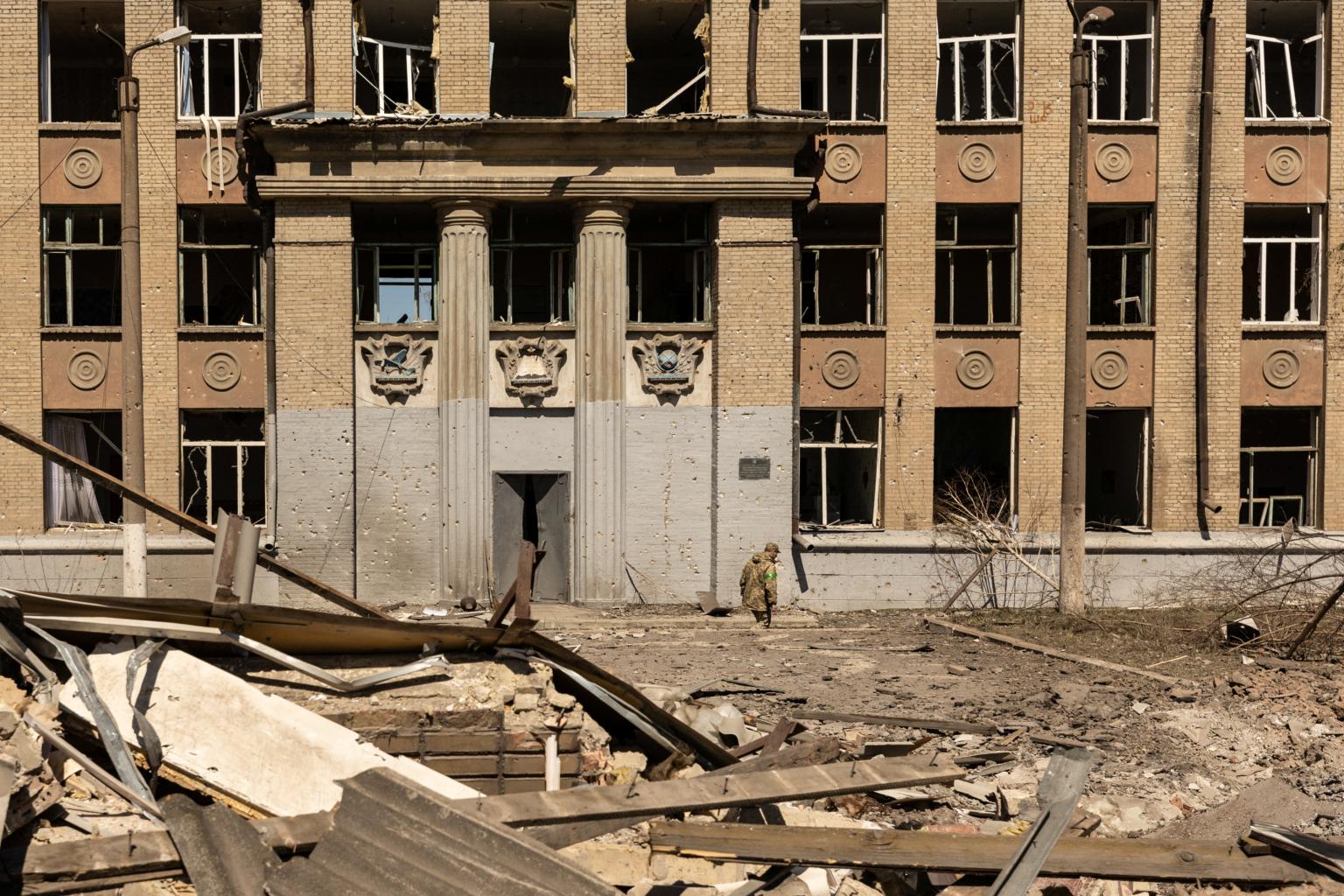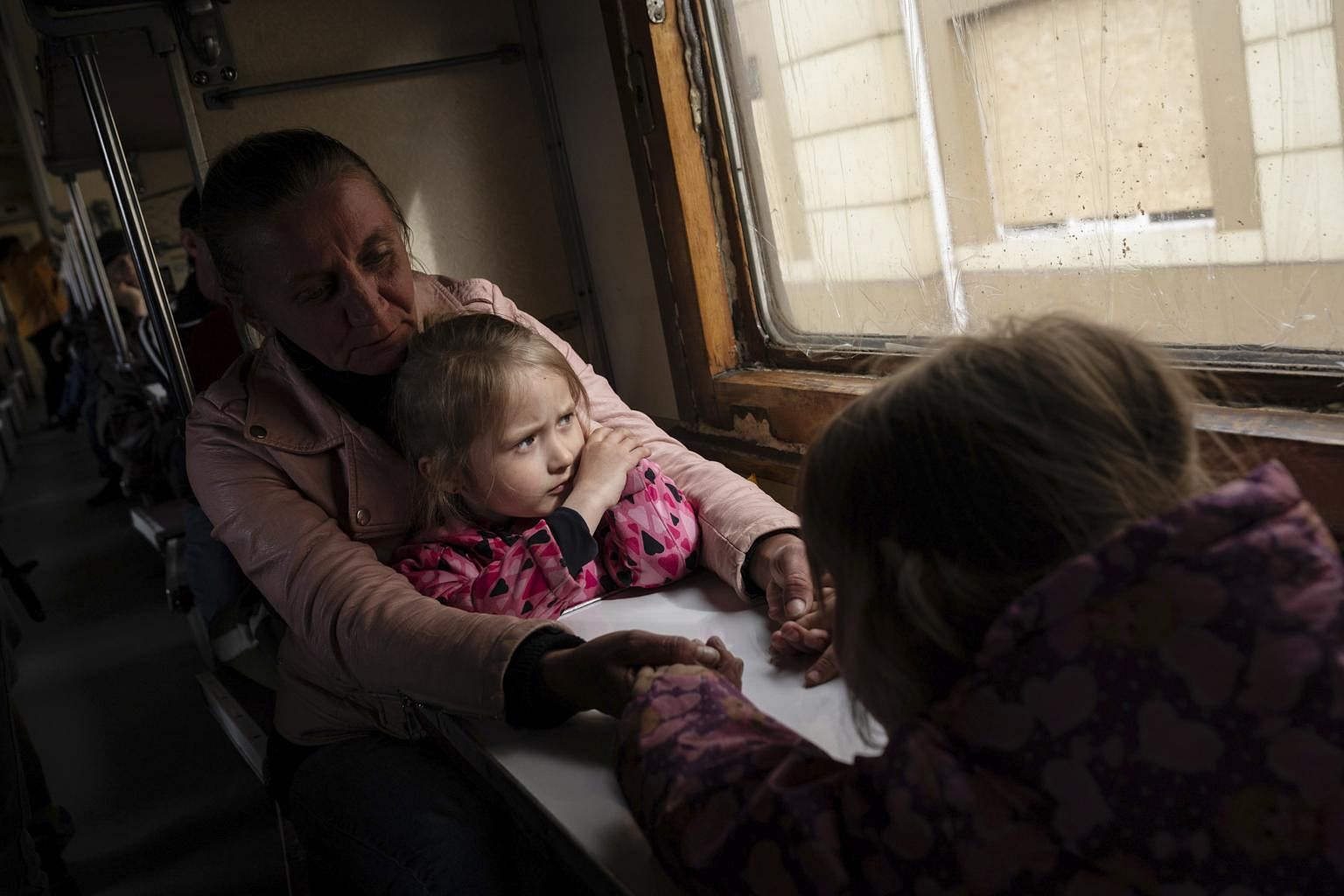Ukraine war's geographic reality: Russia has seized much of the east
Sign up now: Get ST's newsletters delivered to your inbox

A Ukrainian soldier walks in front of a school that was bombed in the Donetsk region in Ukraine on May 8, 2022.
PHOTO: REUTERS
Follow topic:
POKROVSK, UKRAINE (NYTIMES) - Russia's nearly three-month-old invasion of neighbouring Ukraine has been punctuated by flawed planning, poor intelligence, barbarity and wanton destruction.
But obscured in the daily fighting is the geographic reality that Russia has made gains on the ground.
The Russian Defence Ministry said on Tuesday (May 10) that its forces in eastern Ukraine had advanced to the border between Donetsk and Luhansk, the two Russian-speaking provinces where Moscow-backed separatists have been fighting Ukraine's army for eight years.
The ministry's assertion, if confirmed, strengthens the prospect that Russia could soon gain complete control over the region, known as the Donbas, compared with one-third of it before the Feb 24 invasion.
That is a far cry from what appeared to be the grand ambitions of President Vladimir Putin of Russia when he launched the invasion: quick and easy seizure of vast swaths of Ukraine, including the capital, Kyiv, the overthrow of a hostile government and a replacement with unquestioned fealty that would ensure Ukraine's subservience.
Nonetheless, the Donbas seizure, combined with the Russian invasion's early success in seizing parts of southern Ukraine adjoining the Crimean peninsula, which Russia illegally annexed in 2014, gives the Kremlin enormous leverage in any future negotiation to halt the conflict.
And the Russians enjoy the added advantage of naval dominance in the Black Sea, the only maritime route for Ukrainian trade, which they have paralysed with an embargo that could eventually starve Ukraine economically and is already contributing to a global grain shortage.
For the past several weeks, Ukrainian and Russian troops have been engaged in a gruelling attrition, often fighting fiercely over small areas, as one village falls into Russian hands on one day, only to be retaken by the Ukrainians a few days later.
"The Russians aren't winning and the Ukrainians aren't winning, and we're at a bit of a stalemate here," said Lieutenant-General Scott Berrier, director of the Pentagon's Defence Intelligence Agency.
Still, Russia has all but achieved one of its primary objectives: seizing a land bridge connecting Russian territory to the Crimean peninsula.
When Mr Putin ordered the invasion, some of his military's most skilled fighters poured out of Crimea and southern Russia, quickly seizing a ribbon of Ukrainian territory along the Sea of Azov. The last stronghold of Ukrainian resistance in this area, at the Azovstal steel plant in Mariupol, has been whittled to a few hundred hungry troops now confined mostly to bunkers.
But efforts by Russian forces to expand and fortify the land bridge have been complicated by Ukrainian forces deployed along an east-west front that undulates through sprawling fields of wheat and occasionally engulfs villages and towns.

It is in the eastern provinces of Donetsk and Luhansk where fighting is the fiercest.
At the main hospital in Kramatorsk, a city in Donetsk, ambulances stream in day and night, carrying soldiers wounded at the front, who describe being pinned down by near constant shelling.
Russian forces now control about 80 per cent of the Donbas, according to Ukrainian officials, and have concentrated their efforts on a pocket of Ukrainian-held territory with Kramatorsk at its centre.

All around the city, the booms of distant fighting can be heard at all hours, and heavy smoke hangs like a morning fog. Almost daily, Russian forces launch rocket attacks and airstrikes on the city itself, but the most punishing violence is reserved for those places in range of Russian artillery.
About 62 miles (100km) northeast of Kramatorsk is Severodonetsk, where Russian artillery, parked about 5 or 6 miles outside the city, rarely relents, making it difficult for the 15,000 or so residents who remain to venture above ground.
Russia's Black Sea blockade of Ukraine has not diminished the Kremlin's desire to gain control of Odesa, the most important Ukrainian port, which has been subjected to several aerial attacks. In the latest, Russian forces fired seven missiles, striking a shopping mall and a consumer goods warehouse and killing at least one person and wounding several more, Ukrainian officials said.

The strike came only hours after European Council President Charles Michel had visited Odesa, where he was forced to take cover in a bomb shelter because of another attack.
Mr Michel, who met with Prime Minister Denys Shmyhal of Ukraine, criticised Russia for strangling Ukrainian grain exports that feed people around the world.
"I saw silos full of grain, wheat and corn ready for export," Mr Michel said in a statement. "This badly needed food is stranded because of the Russian war and blockade of Black Sea ports, causing dramatic consequences for vulnerable countries."
President Volodymyr Zelensky of Ukraine urged the international community to pressure Russia to lift the blockade.
"For the first time in decades there is no usual movement of the merchant fleet, no usual port functioning in Odesa," he said in an overnight address. "Probably, this has never happened in Odesa since World War II."


